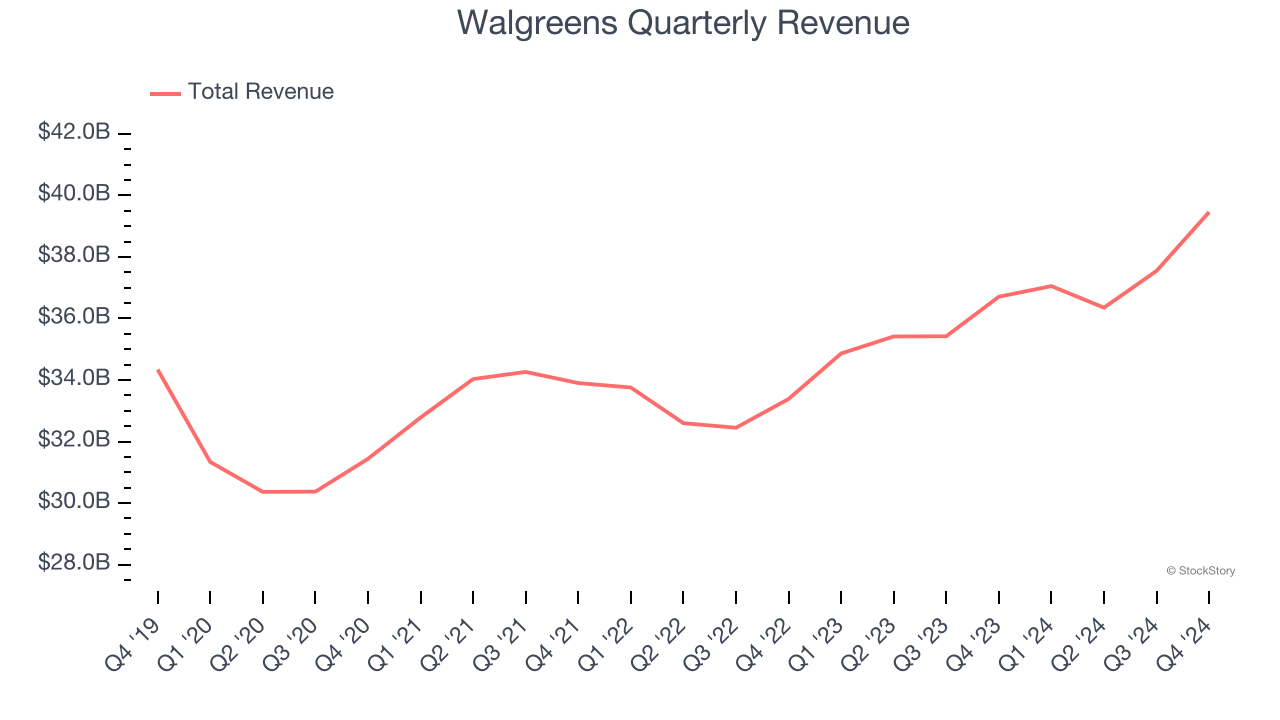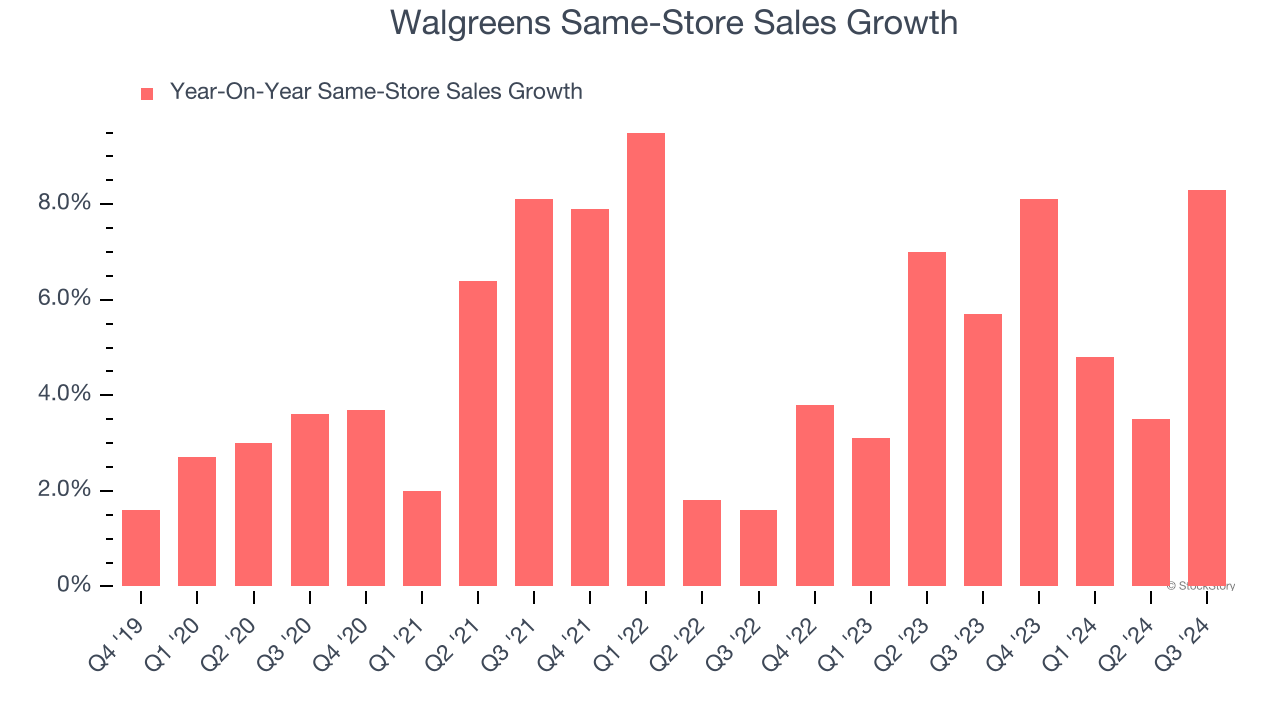Pharmacy chain Walgreens Boots Alliance (NASDAQ:WBA) beat Wall Street’s revenue expectations in Q4 CY2024, with sales up 7.5% year on year to $39.46 billion. Its non-GAAP profit of $0.51 per share was 35.1% above analysts’ consensus estimates.
Is now the time to buy Walgreens? Find out by accessing our full research report, it’s free.
Walgreens (WBA) Q4 CY2024 Highlights:
- Revenue: $39.46 billion vs analyst estimates of $37.42 billion (7.5% year-on-year growth, 5.5% beat)
- Adjusted EPS: $0.51 vs analyst estimates of $0.38 (35.1% beat)
- Adjusted EBITDA: $418 million vs analyst estimates of $717 million (1.1% margin, 41.7% miss)
- Adjusted EPS guidance for the full year is $1.60 at the midpoint, beating analyst estimates by 4.7%
- Operating Margin: -0.6%, in line with the same quarter last year
- Free Cash Flow was -$424 million compared to -$787 million in the same quarter last year
- Market Capitalization: $7.96 billion
“Our first quarter results reflect our disciplined execution against our 2025 priorities: stabilizing the retail pharmacy by optimizing our footprint, controlling operating costs, improving cash flow and continuing to address reimbursement models”Post this Chief Executive Officer Tim Wentworth said:
Company Overview
Primarily offering prescription medicine, health, and beauty products, Walgreens Boots Alliance (NASDAQ:WBA) is a pharmacy chain formed through the 2014 major merger of American company Walgreens and European company Alliance Boots.
General Merchandise Retail
General merchandise retailers–also called broadline retailers–know you’re busy and don’t want to drive around wasting time and gas, so they offer a one-stop shop. Convenience is the name of the game, so these stores may sell clothing in one section, toys in another, and home decor in a third. This concept has evolved over time from department stores to more niche concepts targeting bargain hunters or young adults, and e-commerce has forced these retailers to be extra sharp in their value propositions to consumers, whether that’s unique product or competitive prices.
Sales Growth
A company’s long-term performance is an indicator of its overall quality. While any business can experience short-term success, top-performing ones enjoy sustained growth for years.
Walgreens is a behemoth in the consumer retail sector and benefits from economies of scale, giving it an edge in distribution. This also enables it to gain more leverage on its fixed costs than smaller competitors and the flexibility to offer lower prices. However, its scale is a double-edged sword because there are only a finite number of places to build new stores, making it harder to find incremental growth.
As you can see below, Walgreens grew its sales at a sluggish 3.8% compounded annual growth rate over the last five years (we compare to 2019 to normalize for COVID-19 impacts). This shows it failed to generate demand in any major way and is a rough starting point for our analysis.

This quarter, Walgreens reported year-on-year revenue growth of 7.5%, and its $39.46 billion of revenue exceeded Wall Street’s estimates by 5.5%.
Looking ahead, sell-side analysts expect revenue to remain flat over the next 12 months, a deceleration versus the last five years. This projection doesn't excite us and implies its products will see some demand headwinds.
Software is eating the world and there is virtually no industry left that has been untouched by it. That drives increasing demand for tools helping software developers do their jobs, whether it be monitoring critical cloud infrastructure, integrating audio and video functionality, or ensuring smooth content streaming. Click here to access a free report on our 3 favorite stocks to play this generational megatrend.
Same-Store Sales
Same-store sales show the change in sales for a retailer's e-commerce platform and brick-and-mortar shops that have existed for at least a year. This is a key performance indicator because it measures organic growth.
Walgreens has been one of the most successful retailers over the last two years thanks to skyrocketing demand within its existing locations. On average, the company has posted exceptional year-on-year same-store sales growth of 5.8%.
Note that Walgreens reports its same-store sales intermittently, so some data points are missing in the chart below.

Key Takeaways from Walgreens’s Q4 Results
We were impressed by how significantly Walgreens blew past analysts’ revenue and EPS expectations this quarter. Adding to the positives, full-year EPS guidance came in above expectations. Overall, we think this was still a decent quarter with some key metrics above expectations. The stock traded up 8.7% to $10.01 immediately after reporting.
Walgreens put up rock-solid earnings, but one quarter doesn’t necessarily make the stock a buy. Let’s see if this is a good investment. We think that the latest quarter is only one piece of the longer-term business quality puzzle. Quality, when combined with valuation, can help determine if the stock is a buy. We cover that in our actionable full research report which you can read here, it’s free.
